Panda99Cheese
New member
Author's note: Those who think Columbus was a barbarian have been lied too and should visit this link for the proven truth:"1492 Christopher Columbus" | Columbus Education Project
A different path
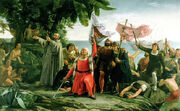
Columbus landing in the Bahamas
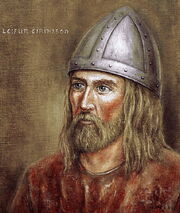
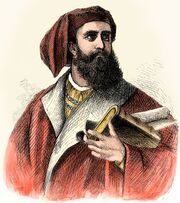
Marco Polo
Christopher Columbus, in this timeline, decides to sail to Cipangu, Modern-Day Japan. The Italian learned of it from reading Marco Polo. His reasoning is that it is closer to China, where he believes the Grand Khan lives. Columbus's goal is to to convert said leader to Christianity, and use his forces to retake Jerusalem from Muslim imperialists. He knows that Japan has gold, which can be used to fund a trip to the Chinese mainland. What he doesn't realize is that the Khans have been overthrown by now. -woodcut.jpg
Setting sail to Greenland and Newfoundland
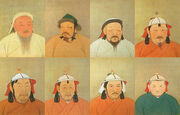
Eight of the fifteen Khan emperors
After finally getting permission and funding from the Spanish Monarchs, after the Reconquista is sucessful, and money from Muslims and Jews is allocated, King Ferdinand and Queen Isabella, Christopher sets sail on August 3, 1492 in the Nina, Pinta, and Santa Maria. He travels north, to the tip of Greenland, gets some more supplies, then heads South through the Labrador Sea and towards modern-day Newfoundland, which he dubs Terra Nova. Having read Leif Ericsson's saga, and knowing the man was a raider as well as a trader, Columbus leaves trinkets on shore as well as weapons to show the inhabitants he means no harm.
Meeting the matriarch
Soon, the residents of the nearest village come to his ship on canoes and greeting are exchanged. Columbus sounds out his name and uses body language to ask the First Nations Canadians if they have the gold material his jewelry is made of. They answer in the negative, but the female Chieftain/shamaness named Ku'ku'kwes tells the Genoese admiral to stay for a day and let her meditate. Columbus agrees, and informed her that rivers and caves are usually where gold is found . He and his men hunt, gather plants, and do other things with the villagers.
The next day, Ku'ku'kwes tells the explorer that she had a vision of a small river connected to a big one that flows into the ocean that has gold, and that the Columbians must travel southeast. The Genoan thanks her and asks her and her people to accompany him; she and they enthusiastically agree. Before leaving Newfoundland, Christopher circumnavigates the island, leaving more treasure and arms, as well as clothes, for other Terra Novan villagers. As with Ku'ku'kwes and her kin, the other indigenous inhabitants of Newfoundland are convinced of his benevolence and wish to come with him, but the ship is full so they must be refused.
Traversing the St. Lawrence
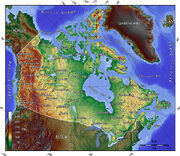
Columbus sails toward what will become the Gulf of St Lawrence, greatly aided by strong winter winds. He and his men fortunately brought bear fur and sheep wool with them, knowing how cold Greenland is and suspecting Japan would be as well. His ships has furs, skins, carcasses, and other animals killed by the Terra Novans. Upon reaching the gulf, Christopher lays one hundred pearls, a red Catholic priest robe, and fifty gold necklaces on the shore, to ward off any hostile attacks, then he and the Spanish sail down the river St Lawrence in their big ships. The wind from the North flows downward, allowing them to traverse it. Like Newfoundland, this area is mostly uninhabited; days go by without seeing a single soul. When natives do appear, they join Columbus and his party, wanting to know more about the strangers who have the unknown shiny substance, and appear to have won over this other tribe. Several times Columbus is asked to stop sailing down the river and come to native villages but he refuses, explaining his end goal and where gold can be found. So the First Nations folk paddle in canoes alongside him.
The Genoese admiral preaches to both Spaniard and indigenous Canadian alike, and regales his native hosts with tales of his people and homeland. Again, due to the language barrier, Columbus and his men move their bodies and draw sketches to get their point across, though they don't stop trying to translate the native language into Spanish. Their comrades from Newfoundland aid them in communication. When it gets too cold, branches are tied together and mobile campfires are built by native Canadians. Small deer, rabbits, wild boar, and squirrels are hunted when food begins to run low, and several bears and mountain lions are killed when they try to attack the boats.
Finding the River of Gold
The Columbians finally reach what is known today as the Rivere Chaudiere. A hostile tribe there, consisting of a twenty-man band, fire arrows at the Spaniards and Newfoundlanders. Columbus strips naked stunning his party and the attackers. He shows the assailants his clothes, arms, and trinkets and once again uses body language to explain what he's looking for. Ku'ku'kwes was his interpreter; several of the band were of the same Innu blood as her people, those that weren't had visited her island home before.

The party leads the Spanish and First Nations folk back to their nomadic tent village, where they are gawked at and observed with awe. The gold trinkets mesmerize the village folk, and after hearing the whole story from Columbus and Ku'ku'kwes, they agree to help without hesitation. This village is led by a medicine man (angakkuq) named Hiksik(which mean marmot) . Using pick-axes, stones, arrows, and swords, the ground is dug up and the dirt is washed away by the water to reveal tiny gold nuggets. Believing Jehovah has guided and blessed him and his crew and allies, Columbus calls the river San Salvador (Holy Savior).
Preparing to leave and Doubts about location
Some of Columbus's men tell him that they believe this land isn't Japan, due to the differences in appearance of the people, the terrain, and the dwelling places from Marco Polo's descriptions. The Genoese sailor dismisses their concerns, but he listens to Ku'ku'kwes when she tells him not to leave any men behind once he decides to return to Spain. Without their leader, the Catholic Spaniards will run amok and cause harm to themselves and the other Cipanguns. He trusts her judgement after her vision led him to the river, and after taking 100 lb. of gold on each the ships, Columbus sails away with the first Newfoundlanders.
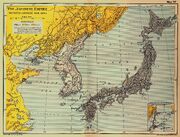
Christopher Columbus allows the Terra Novans to take as many pieces of gold as they can carry, in exchange for helping him. Once back on their home island, they show off their loot to the Canadians left behind, who are as amazed as when the explorers first showed it to them. They agree to his request to return to the River Chaudiere and continue mining for the precious metal. To decide who will return with him to the Spanish Kingdom, aside from chief Ku'ku'kwes, the Genoan tears up 3 loaves of bread into a hundred pieces; those with the biggest pieces are allowed on his ships.
Return to Spain in Triumph
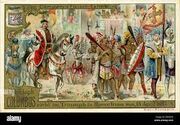
Columbus triumphant return to Spain
Columbus returns to Barcelona, Spain on Palm Sunday, April 2nd 1493, and is given the same treatment as Jesus was in Jerusalem. Alongside Ku'ku'kwes is her grandson Kizis, whose mother and grandmother have allowed the Genoan to adopt as his son. The Spanish monarchs are pleased to see the gold, but puzzled by the lack of spices Japan is known to have; Columbus only brings back cinnamon. They are also puzzled by the way native Canadians dress and Columbus's descriptions of their homes, which don't match Marco Polo's descriptions of the Japanese. For now though, they accept his proclamation that he reached Japan/Cipangu. They also accept Columbus's proposal to come with him on his next voyage to the New World and form alliance with the Japanese Shogun and Emperor. He believes that this will make extracting gold much easier, and reduce conflicts between Europeans and the First Nations folk.
The king and queen in Canada
After giving Columbus the position of viceroy, Ferdinand and Isabella put together a massive fleet, using every available ship, including civilian ones, and sail to Canada/Cipangu. Their first stop is Terra Nova/Newfoundland. It's inhabitants are even more shocked by their appearance than they were Columbus. Not only are there many more strangers than last time, but they have majestic horses, dogs that look much different from their Siberian huskies, gold coins with faces/symbols, jewels (bigger than the ones embedded in Christopher's trinkets) and armor made of silver. Columbus showed them guns, cannons, swords, and spears on his first landing, but the Spanish visitors have so many now. The royal regalia of the Spanish rulers is especially enticing, and the Terra Novans are allowed to grasp their garments and crowns, though they are closely watched. After three days on Newfoundland, the royal party heads toward San Salvador/Rivere Chaudiere. There they see the gold nuggets, that are still being gathered by native Canadians.
Falling out between the explorer and Monarchs
Columbus had asked Ku'ku'kwes and their people, as well as Hiksik and his, if they knew about the emperor and shogun; they responded in the negative. He chalked this up to them living in a remote area, and being unexposed to the larger world. But as he and his sponsors travel deeper into Canada and meet more and more indigenous folk, all of them express the same ignorance of Japanese imperialism and feudalism. This, more so than the lack of spices and differences in physical, clothing, and housing appearance convinces Isabella and Ferdinand that their protege has discovered an entirely new land. The Genoan refuses to accept what is right in front of his face however, confusing to insist this land is Asian and Japanese. Irritated by his stubbornness, Isabella and her husband revoke his governorship and make Canada a royal colony, which means it is directly under their control. They dub it New Cipangu, and repeatedly offer Columbus his governorship back if he admits he found New World. When the Genoese sailor repeatedly refuses to relent, the angry monarchs go further and revoke his noble titles, though they still give him credit for discovering Canada, and allow him to retain his wealth.
Trade and Blockade
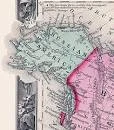
Russian America
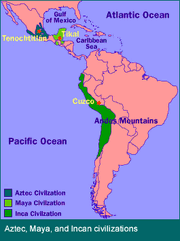
Aztec, Mayan, and Incan Empires
Unlike the primary timeline, neither conquistadors nor anyone else is sent to conquer Canada. With the exception of Gold, Canada has little of value to Spain. On top of that, most of it is uninhabited, not surprising due to the cold climate and the treacherous terrain. While claiming the Nation as their own, no New Cipangun land is occupied by the Spanish military, and for a long time not even any permanent settlements are built. Spain and the terra novans and other Canadian First Nations tribes trade with each other. Once business is concluded, they part ways. And it's almost always gold; Spain has no interest in fur, maple, meat, lumber, coal, or oil. This fact, and the lack of Empires in Canada (unlike Latin America with the Mayan, Aztec, and Incan imperialists), means that violence is sporadic and isolated. The Queen and King, wanting to maintain their lucrative partnership, swiftly jail and execute Spaniards who abuse First Nations Canadians. They also set a blockade around the Canadian coast to prevent other European powers, specifically France and Russia, from getting in on their action. The Spaniards also take control of modern-day Alaska (once they reach western Canada), charging the Russians who first found the future state a high tariff in order to continue trading with Alaska Natives. Russia isn't happy with this and began planning the (eventual) conquest for Alaska against Spain.
In response to Spain's actions, the French send explorers and traders to the Caribbean, while the British head to what is the Mainland United States. This causes the Soveriegns to strengthen their Canadian defenses. Forts and bases are built along New Cipangu's coast; eventually they will become cities. Soon the Spanish crown decides that they can't allow France and Britain to set up their own fiefdoms in the lower 48 or Caribbean Sea, and mobilize their forces for inevitable conflict. What if Columbus settled in Canada?
What do you think of my scenario? Do you have a better one? After visiting columbusedproject.org, please work to correct long-unchallenged anti-Columbus agitprop on the internet/worldwide web?! Inaction against it has resulted in him being cancelled in many places! If his reputation is destroyed, then America will be delegitimized and a cultural communist revolution will ensue just like in China! I’m a proud patriot!
A different path

Columbus landing in the Bahamas


Marco Polo
Christopher Columbus, in this timeline, decides to sail to Cipangu, Modern-Day Japan. The Italian learned of it from reading Marco Polo. His reasoning is that it is closer to China, where he believes the Grand Khan lives. Columbus's goal is to to convert said leader to Christianity, and use his forces to retake Jerusalem from Muslim imperialists. He knows that Japan has gold, which can be used to fund a trip to the Chinese mainland. What he doesn't realize is that the Khans have been overthrown by now. -woodcut.jpg
Setting sail to Greenland and Newfoundland

Eight of the fifteen Khan emperors
After finally getting permission and funding from the Spanish Monarchs, after the Reconquista is sucessful, and money from Muslims and Jews is allocated, King Ferdinand and Queen Isabella, Christopher sets sail on August 3, 1492 in the Nina, Pinta, and Santa Maria. He travels north, to the tip of Greenland, gets some more supplies, then heads South through the Labrador Sea and towards modern-day Newfoundland, which he dubs Terra Nova. Having read Leif Ericsson's saga, and knowing the man was a raider as well as a trader, Columbus leaves trinkets on shore as well as weapons to show the inhabitants he means no harm.
Meeting the matriarch
Soon, the residents of the nearest village come to his ship on canoes and greeting are exchanged. Columbus sounds out his name and uses body language to ask the First Nations Canadians if they have the gold material his jewelry is made of. They answer in the negative, but the female Chieftain/shamaness named Ku'ku'kwes tells the Genoese admiral to stay for a day and let her meditate. Columbus agrees, and informed her that rivers and caves are usually where gold is found . He and his men hunt, gather plants, and do other things with the villagers.
The next day, Ku'ku'kwes tells the explorer that she had a vision of a small river connected to a big one that flows into the ocean that has gold, and that the Columbians must travel southeast. The Genoan thanks her and asks her and her people to accompany him; she and they enthusiastically agree. Before leaving Newfoundland, Christopher circumnavigates the island, leaving more treasure and arms, as well as clothes, for other Terra Novan villagers. As with Ku'ku'kwes and her kin, the other indigenous inhabitants of Newfoundland are convinced of his benevolence and wish to come with him, but the ship is full so they must be refused.
Traversing the St. Lawrence

Columbus sails toward what will become the Gulf of St Lawrence, greatly aided by strong winter winds. He and his men fortunately brought bear fur and sheep wool with them, knowing how cold Greenland is and suspecting Japan would be as well. His ships has furs, skins, carcasses, and other animals killed by the Terra Novans. Upon reaching the gulf, Christopher lays one hundred pearls, a red Catholic priest robe, and fifty gold necklaces on the shore, to ward off any hostile attacks, then he and the Spanish sail down the river St Lawrence in their big ships. The wind from the North flows downward, allowing them to traverse it. Like Newfoundland, this area is mostly uninhabited; days go by without seeing a single soul. When natives do appear, they join Columbus and his party, wanting to know more about the strangers who have the unknown shiny substance, and appear to have won over this other tribe. Several times Columbus is asked to stop sailing down the river and come to native villages but he refuses, explaining his end goal and where gold can be found. So the First Nations folk paddle in canoes alongside him.
The Genoese admiral preaches to both Spaniard and indigenous Canadian alike, and regales his native hosts with tales of his people and homeland. Again, due to the language barrier, Columbus and his men move their bodies and draw sketches to get their point across, though they don't stop trying to translate the native language into Spanish. Their comrades from Newfoundland aid them in communication. When it gets too cold, branches are tied together and mobile campfires are built by native Canadians. Small deer, rabbits, wild boar, and squirrels are hunted when food begins to run low, and several bears and mountain lions are killed when they try to attack the boats.
Finding the River of Gold
The Columbians finally reach what is known today as the Rivere Chaudiere. A hostile tribe there, consisting of a twenty-man band, fire arrows at the Spaniards and Newfoundlanders. Columbus strips naked stunning his party and the attackers. He shows the assailants his clothes, arms, and trinkets and once again uses body language to explain what he's looking for. Ku'ku'kwes was his interpreter; several of the band were of the same Innu blood as her people, those that weren't had visited her island home before.

The party leads the Spanish and First Nations folk back to their nomadic tent village, where they are gawked at and observed with awe. The gold trinkets mesmerize the village folk, and after hearing the whole story from Columbus and Ku'ku'kwes, they agree to help without hesitation. This village is led by a medicine man (angakkuq) named Hiksik(which mean marmot) . Using pick-axes, stones, arrows, and swords, the ground is dug up and the dirt is washed away by the water to reveal tiny gold nuggets. Believing Jehovah has guided and blessed him and his crew and allies, Columbus calls the river San Salvador (Holy Savior).
Preparing to leave and Doubts about location
Some of Columbus's men tell him that they believe this land isn't Japan, due to the differences in appearance of the people, the terrain, and the dwelling places from Marco Polo's descriptions. The Genoese sailor dismisses their concerns, but he listens to Ku'ku'kwes when she tells him not to leave any men behind once he decides to return to Spain. Without their leader, the Catholic Spaniards will run amok and cause harm to themselves and the other Cipanguns. He trusts her judgement after her vision led him to the river, and after taking 100 lb. of gold on each the ships, Columbus sails away with the first Newfoundlanders.

Christopher Columbus allows the Terra Novans to take as many pieces of gold as they can carry, in exchange for helping him. Once back on their home island, they show off their loot to the Canadians left behind, who are as amazed as when the explorers first showed it to them. They agree to his request to return to the River Chaudiere and continue mining for the precious metal. To decide who will return with him to the Spanish Kingdom, aside from chief Ku'ku'kwes, the Genoan tears up 3 loaves of bread into a hundred pieces; those with the biggest pieces are allowed on his ships.
Return to Spain in Triumph

Columbus triumphant return to Spain
Columbus returns to Barcelona, Spain on Palm Sunday, April 2nd 1493, and is given the same treatment as Jesus was in Jerusalem. Alongside Ku'ku'kwes is her grandson Kizis, whose mother and grandmother have allowed the Genoan to adopt as his son. The Spanish monarchs are pleased to see the gold, but puzzled by the lack of spices Japan is known to have; Columbus only brings back cinnamon. They are also puzzled by the way native Canadians dress and Columbus's descriptions of their homes, which don't match Marco Polo's descriptions of the Japanese. For now though, they accept his proclamation that he reached Japan/Cipangu. They also accept Columbus's proposal to come with him on his next voyage to the New World and form alliance with the Japanese Shogun and Emperor. He believes that this will make extracting gold much easier, and reduce conflicts between Europeans and the First Nations folk.
The king and queen in Canada
After giving Columbus the position of viceroy, Ferdinand and Isabella put together a massive fleet, using every available ship, including civilian ones, and sail to Canada/Cipangu. Their first stop is Terra Nova/Newfoundland. It's inhabitants are even more shocked by their appearance than they were Columbus. Not only are there many more strangers than last time, but they have majestic horses, dogs that look much different from their Siberian huskies, gold coins with faces/symbols, jewels (bigger than the ones embedded in Christopher's trinkets) and armor made of silver. Columbus showed them guns, cannons, swords, and spears on his first landing, but the Spanish visitors have so many now. The royal regalia of the Spanish rulers is especially enticing, and the Terra Novans are allowed to grasp their garments and crowns, though they are closely watched. After three days on Newfoundland, the royal party heads toward San Salvador/Rivere Chaudiere. There they see the gold nuggets, that are still being gathered by native Canadians.
Falling out between the explorer and Monarchs
Columbus had asked Ku'ku'kwes and their people, as well as Hiksik and his, if they knew about the emperor and shogun; they responded in the negative. He chalked this up to them living in a remote area, and being unexposed to the larger world. But as he and his sponsors travel deeper into Canada and meet more and more indigenous folk, all of them express the same ignorance of Japanese imperialism and feudalism. This, more so than the lack of spices and differences in physical, clothing, and housing appearance convinces Isabella and Ferdinand that their protege has discovered an entirely new land. The Genoan refuses to accept what is right in front of his face however, confusing to insist this land is Asian and Japanese. Irritated by his stubbornness, Isabella and her husband revoke his governorship and make Canada a royal colony, which means it is directly under their control. They dub it New Cipangu, and repeatedly offer Columbus his governorship back if he admits he found New World. When the Genoese sailor repeatedly refuses to relent, the angry monarchs go further and revoke his noble titles, though they still give him credit for discovering Canada, and allow him to retain his wealth.
Trade and Blockade

Russian America

Aztec, Mayan, and Incan Empires
Unlike the primary timeline, neither conquistadors nor anyone else is sent to conquer Canada. With the exception of Gold, Canada has little of value to Spain. On top of that, most of it is uninhabited, not surprising due to the cold climate and the treacherous terrain. While claiming the Nation as their own, no New Cipangun land is occupied by the Spanish military, and for a long time not even any permanent settlements are built. Spain and the terra novans and other Canadian First Nations tribes trade with each other. Once business is concluded, they part ways. And it's almost always gold; Spain has no interest in fur, maple, meat, lumber, coal, or oil. This fact, and the lack of Empires in Canada (unlike Latin America with the Mayan, Aztec, and Incan imperialists), means that violence is sporadic and isolated. The Queen and King, wanting to maintain their lucrative partnership, swiftly jail and execute Spaniards who abuse First Nations Canadians. They also set a blockade around the Canadian coast to prevent other European powers, specifically France and Russia, from getting in on their action. The Spaniards also take control of modern-day Alaska (once they reach western Canada), charging the Russians who first found the future state a high tariff in order to continue trading with Alaska Natives. Russia isn't happy with this and began planning the (eventual) conquest for Alaska against Spain.
In response to Spain's actions, the French send explorers and traders to the Caribbean, while the British head to what is the Mainland United States. This causes the Soveriegns to strengthen their Canadian defenses. Forts and bases are built along New Cipangu's coast; eventually they will become cities. Soon the Spanish crown decides that they can't allow France and Britain to set up their own fiefdoms in the lower 48 or Caribbean Sea, and mobilize their forces for inevitable conflict. What if Columbus settled in Canada?
What do you think of my scenario? Do you have a better one? After visiting columbusedproject.org, please work to correct long-unchallenged anti-Columbus agitprop on the internet/worldwide web?! Inaction against it has resulted in him being cancelled in many places! If his reputation is destroyed, then America will be delegitimized and a cultural communist revolution will ensue just like in China! I’m a proud patriot!
